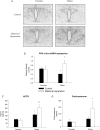Neonatal maternal separation and sex-specific plasticity of the hypoxic ventilatory response in awake rat
- PMID: 14634199
- PMCID: PMC1664780
- DOI: 10.1113/jphysiol.2003.052894
Neonatal maternal separation and sex-specific plasticity of the hypoxic ventilatory response in awake rat
Abstract
We tested the hypothesis that neonatal maternal separation (NMS), a form of stress that affects hypothalamo-pituitary-adrenal axis (HPA) function in adult rats, alters development of the respiratory control system. Pups subjected to NMS were placed in a temperature and humidity controlled incubator 3 h per day for 10 consecutive days (P3 to P12). Control pups were undisturbed. Once they reached adulthood (8-10 weeks old), rats were placed in a plethysmography chamber for measurement of ventilatory and cardiovascular parameters under normoxic and hypoxic conditions. Measurement of c-fos mRNA expression in the paraventricular nucleus of the hypothalamus (PVH) combined with plasma ACTH and corticosterone levels confirmed that NMS effectively disrupted HPA axis function in males. In males, baseline minute ventilation was not affected by NMS. In contrast, NMS females show a greater resting minute ventilation due to a larger tidal volume. The hypoxic ventilatory response of male NMS rats was 25% greater than controls, owing mainly to an increase in tidal volume response. This augmentation of the hypoxic ventilatory response was sex-specific also because NMS females show an attenuated minute ventilation increase. Baseline mean arterial blood pressure of male NMS rats was 20% higher than controls. NMS-related hypertension was not significant in females. The mechanisms underlying sex-specific disruption of cardio-respiratory control in NMS rats are unknown but may be a consequence of the neuroendocrine disruption associated with NMS. These data indicate that exposure to a non-respiratory stress during early life elicits significant plasticity of these homeostatic functions which persists until adulthood.
Figures





Similar articles
-
Neonatal maternal separation induces sex-specific augmentation of the hypercapnic ventilatory response in awake rat.J Appl Physiol (1985). 2007 Apr;102(4):1416-21. doi: 10.1152/japplphysiol.00454.2006. Epub 2006 Dec 21. J Appl Physiol (1985). 2007. PMID: 17185497
-
Neonatal maternal separation and enhancement of the hypoxic ventilatory response in rat: the role of GABAergic modulation within the paraventricular nucleus of the hypothalamus.J Physiol. 2007 Aug 15;583(Pt 1):299-314. doi: 10.1113/jphysiol.2007.135160. Epub 2007 Jun 14. J Physiol. 2007. PMID: 17569732 Free PMC article.
-
Neonatal maternal separation disrupts regulation of sleep and breathing in adult male rats.Sleep. 2009 Dec;32(12):1611-20. doi: 10.1093/sleep/32.12.1611. Sleep. 2009. PMID: 20041597 Free PMC article.
-
Testosterone potentiates the hypoxic ventilatory response of adult male rats subjected to neonatal stress.Exp Physiol. 2014 May 1;99(5):824-34. doi: 10.1113/expphysiol.2013.077073. Epub 2014 Mar 7. Exp Physiol. 2014. PMID: 24610832
-
Neonatal maternal separation and early life programming of the hypoxic ventilatory response in rats.Respir Physiol Neurobiol. 2005 Nov 15;149(1-3):313-24. doi: 10.1016/j.resp.2005.04.014. Respir Physiol Neurobiol. 2005. PMID: 15894516 Review.
Cited by
-
Unstable maternal environment, separation anxiety, and heightened CO2 sensitivity induced by gene-by-environment interplay.PLoS One. 2011 Apr 8;6(4):e18637. doi: 10.1371/journal.pone.0018637. PLoS One. 2011. PMID: 21494633 Free PMC article.
-
Gestational intermittent hypoxia increases susceptibility to neuroinflammation and alters respiratory motor control in neonatal rats.Respir Physiol Neurobiol. 2018 Oct;256:128-142. doi: 10.1016/j.resp.2017.11.007. Epub 2017 Nov 22. Respir Physiol Neurobiol. 2018. PMID: 29174411 Free PMC article. Review.
-
Neonatal Maternal Separation Augments Carotid Body Response to Hypoxia in Adult Males but Not Female Rats.Front Physiol. 2016 Sep 27;7:432. doi: 10.3389/fphys.2016.00432. eCollection 2016. Front Physiol. 2016. PMID: 27729873 Free PMC article.
-
On the origins of sleep disordered breathing, cardiorespiratory and metabolic dysfunction: which came first, the chicken or the egg?J Physiol. 2023 Dec;601(24):5509-5525. doi: 10.1113/JP284113. Epub 2023 Apr 15. J Physiol. 2023. PMID: 36988138 Free PMC article.
-
Different patterns of respiration in rat lines selectively bred for high or low anxiety.PLoS One. 2013 May 17;8(5):e64519. doi: 10.1371/journal.pone.0064519. Print 2013. PLoS One. 2013. PMID: 23691240 Free PMC article.
References
-
- Akil H, Campeau S, Culliman WE, Lechan RM, Toni R, Watson SJ, Moore RY. Neuroendocrine systems I: Overview – Thyroid and adrenal axes. In: Zigmond MJ, Bloom FE, Landis SC, Roberts JL, Squire LR, editors. Fundamental Neuroscience. Academic Press, San Diego: 1999. pp. 1127–1150. chapter 43.
-
- Anisman H, Zaharia MD, Meaney MJ, Merali Z. Do early-life events permanently alter behavioral and hormonal responses to stressors. Int J Dev Neurosci. 1998;16:149–164. - PubMed
-
- Beck KD, Luine VN. Sex differences in behavioral and neurochemical profiles after chronic stress. Role of housing conditions. Physiol Behav. 2002;75:661–673. - PubMed
-
- Berquin P, Bodineau L, Gros F, Larnicol N. Brainstem and hypothalamic areas involved in respiratory chemoreflexes: a Fos study in adult rats. Brain Res. 2000a;857:30–40. - PubMed
-
- Berquin P, Cayetanot F, Gros F, Larnicol N. Postnatal changes in Fos-like immunoreactivity evoked by hypoxia in the rat brainstem and hypothalamus. Brain Res. 2000b;877:149–159. - PubMed
Publication types
MeSH terms
LinkOut - more resources
Full Text Sources

